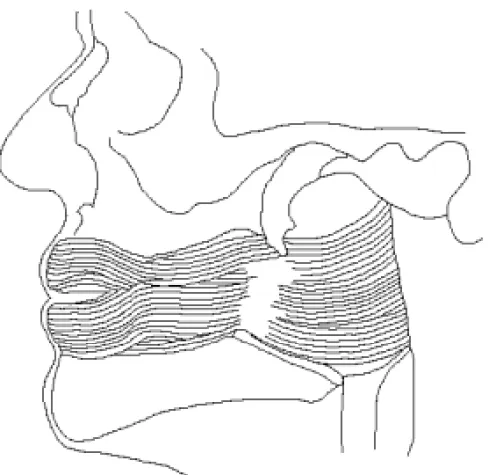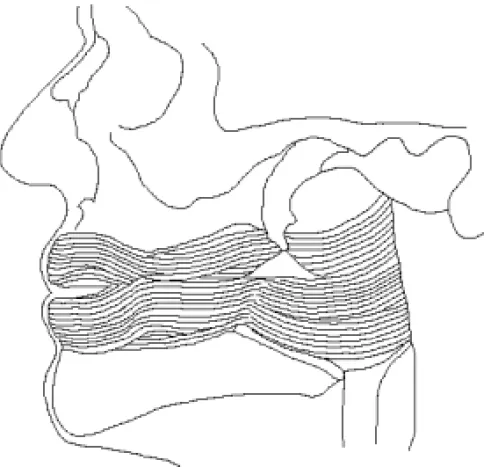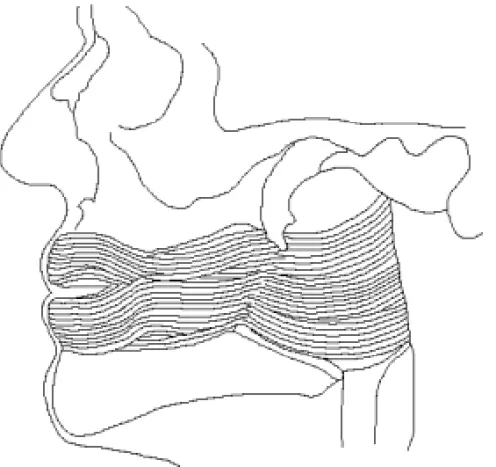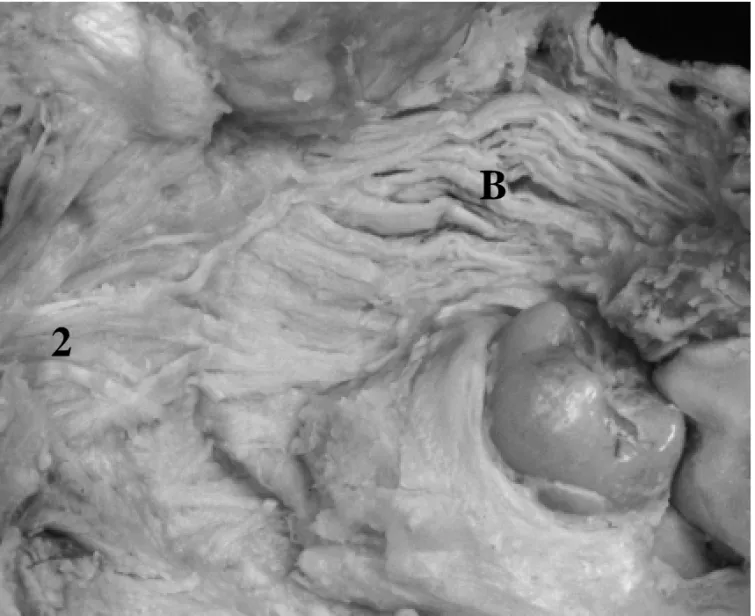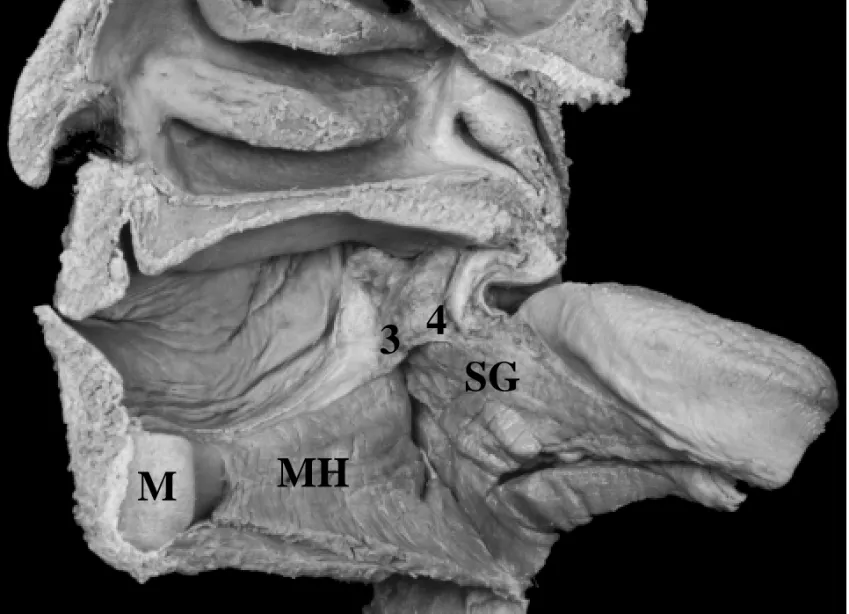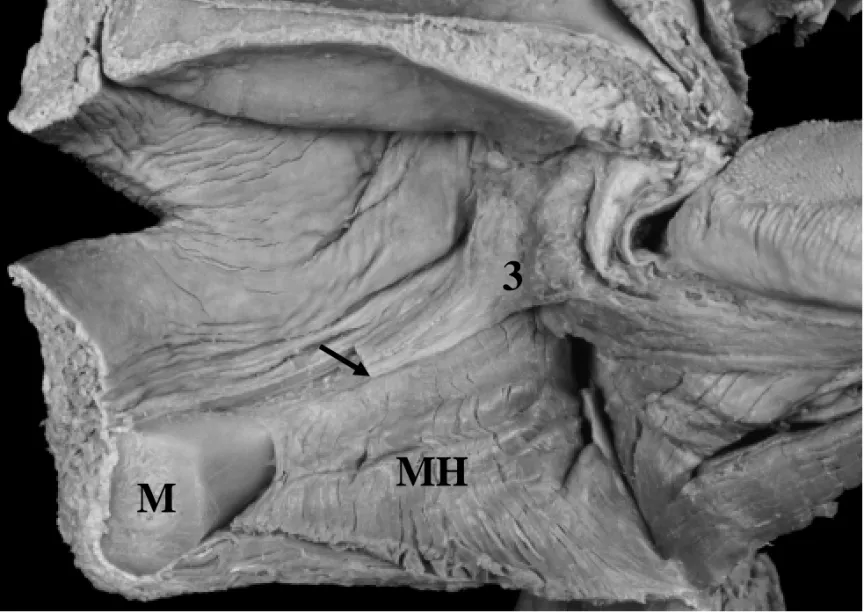IRUCAA@TDC : Morphologic characteristics of the superior pharyngeal constrictor muscle in relation to the function during swallowing
全文
(2) Morphologic Characteristics of the Superior Pharyngeal Constrictor Muscle in Relation to the Function During Swallowing. Nobuaki Tsumori, DDS,1 Shinichi Abe, DDS, PhD, 1 Hiroko Agematsu, BH, PhD, 1 Masatsugu Hashimoto, BS, PhD, 2 and Yoshinobu Ide, DDS, PhD, 1. 1. Department of Anatomy, Tokyo Dental College, 1-2-2 Masago, Mihama-ku, Chiba-city,. Chiba 261-8502, Japan 2. Department of Forensic Anthropology, Tokyo Dental College, 1-2-2 Masago,. Mihama-ku, Chiba-shi, Chiba 261-8502, Japan. Short running title: Morphological studies of the superior pharyngeal constrictor muscle. Corresponding auther : Shinichi Abe Department of Anatomy, Tokyo Dental College, 1-2-2 Masago, Mihama-ku, Chiba-city, Chiba 261-8502, Japan Tel: 81-43-270-3571 Fax: 81-43-277-4010 E- mail: shinabe@tdc.ac.jp. 1.
(3) Abstract To clarify the morphological characteristics of the superior pharyngeal constrictor muscle which plays an important role in swallowing, the gross anatomy of the pterygopharyngeal, buccopharyngeal, mylopharyngeal and glossopharyngeal parts of the muscle was examined. Morphology of the origin of the muscle at the buccopharyngeal part could be divided into three types: type A, membranous morphology from superior to inferior areas; type B, membranous only in superior area; and type C, comp lete lack of membrane. In all three types, the muscle at the buccopharyngeal part transitionally originated from the buccinator muscle. Morphology of the origin of the muscle at the mylopharyngeal part could be divided into two types: type A, tip of the origin on the mylohyoid line; and type B, tip of the origin away from the mylohyoid line. The present study indicated that the superior pharyngeal constrictor muscle attached to the buccinator muscle (which plays an important role in mastication) with mucosa, and originated from the mandible and root of the tongue. These findings suggest that the superior pharyngeal constrictor muscle may also play an important role in the expression of smooth coordinated movements associated with ingestion, from mastication to swallowing. Key words: Superior pharyngeal constrictor muscle - Buccinator muscle – Tongue Swallowing - Pharynx 2.
(4) Introduction In recent years, dysphagia or age- induced functional reductions in ingestion have become relevant to clinical issues, and oropharyngeal movements from mastication to swallowing are being closely examined to solve these problems . Its mechanism is thus being clarified. It is well known that the pharyngeal constrictor muscles are relating to swallowing. The pharyngeal constrictor muscles forming the posterior wall of the pharynx consist of three muscles, namely, superior, middle and inferior pharyngeal constrictor muscles [1-8]. Previous anatomical studies have sought to ascertain the morphological and muscular properties of the inferior pharyngeal constrictor muscle adjacent to the esophagus [9-11]. In those studies, movements of this muscle were discussed from the perspective of anatomical structures. On the other hand, the superior pharyngeal constrictor muscle adjacent to the oral cavity displays a complicated morphology with four origins and one insertion. This muscle can be divided into four parts based on differences in origin: the pterygopharyngeal part originating from the pterygoid hamulus of the sphenoid bone; the buccopharyngeal part originating from the pterygomandibular raphe; the mylopharyngeal part originating from the mylohyoid line; and the glossopharyngeal. 3.
(5) part originating from the tongue [4,7,8,12]. Anatomical study on this muscle was reported by Howland and Brodie [13]. They observed the pterygomandibular raphe at the buccopharyngeal part and described as "the sphenoid tendon between the jaws". Also, Brand [6] reported that the raphe a tendinous band and Williams [4] described the raphe as tendinous fibers. Sicher [14] reported that the raphe forms a tendinous structure, and except for this intermediate area, a continuous sphincter muscle- like band is formed. However, Gaughran [15] reported that the pterygomandibular raphe is missing 100% of cases, and the raphe that had been described was an anatomical artifact. Therefore, the conclusion does not yet become clear. At the other parts of the superior pharyngeal constrictor muscle, the morphology of the glossopharyngeal part has been reported in recent years [16]. Morphologies of the pterygopharyngeal and mylopharyngeal parts, however, have remained unclear. In other words, there are few studies on the total images of the superior pharyngeal constrictor muscle. The aim of this study was to clarify the morphological characteristics of the superior pharyngeal constrictor muscle by the gross anatomical observation, which was conducted to ascertain the origins, insertion and muscle alignments of the four parts.. 4.
(6) Materials and Methods The materials used in this study were 37 cadavers of Japanese adults (24 males and 13 females; age range = 53-91 years with a mean of 73 years) provided for anatomical practice to the Department of Anatomy at Tokyo Dental College. The cadavers were fixed with 10% formaldehyde. 1. Dissection of the superior pharyngeal constrictor muscle The facial muscles excluding the buccinator muscle, masticatory muscles, zygomatic arch and part of the mandibular ramus were removed. Tissue on the posterior side of the cervical vertebrae was also removed. The superior pharyngeal constrictor muscle was then observed from the facial side (Fig. 1). Next, the head was sliced in median sagittal sections, and the oral mucosa was removed. The superior pharyngeal constrictor muscle was then observed from the oral side. 2. Gross anatomical observation of the superior pharyngeal constrictor muscle 1) Morphology of the origin (1) Pterygopharyngeal part Morphology of the origin of the muscle at the pterygopharyngeal part was observed from the facial side. (2) Buccopharyngeal part. 5.
(7) Morphology of the origin of the muscle at the buccopharyngeal part was observed from the facial side. (3) Mylopharyngeal part Morphology of the origin of the muscle at the mylopharyngeal part was observed from the oral side. (4) Glossopharyngeal part Morphology of the origin of the muscle at the glossopharyngeal part was observed from the oral side. 2) Morphology of the insertion The insertion of the pharyngeal constrictor muscles at the posterior pharyngeal wall was observed from the facial side. 3. Histological observation of the superior pharyngeal constrictor muscle at the buccopharyngeal part The superior pharyngeal constrictor muscle at the buccopharyngeal part (which originates from the fourth and sixth branchial arches) comes in contact with the buccinator muscle (which originates from the second branchial arch), which displays a different embryological origin. To clarify this relationship, macroscopic and histological analyses were performed. After macroscopic observation, the buccinator muscle and. 6.
(8) superior pharyngeal constrictor muscle at the buccopharyngeal part were removed in a single mass. The mass was fixed again in 10% formaldehyde and embedded in paraffin according to conventional methods. Then, 8 µm serial sections were prepared parallel to the alignment of muscle fibers from lateral to medial sides. These sections were subjected to Azan staining and then observed under light microscopy.. Results Though 24 male and 13 female cadavers were used as materia ls in this study, no gender differences in morphology of the four parts of the superior pharyngeal constrictor muscle were identified. Therefore the numbers of the materials belonging to each type at the origin and the insertion of the superior pharyngeal constrictor muscle were counted without discriminating the gender. 1. Gross anatomical observation of the superior pharyngeal constrictor muscle 1) Morphology of the origin (1) Pterygopharyngeal part The most superior area of the superior pharyngeal constrictor muscle corresponded to the pterygopharyngeal part, and the muscle at this part originated between the pterygoid hamulus of the sphenoid bone and the posterior margin of the medial pterygoid plate of. 7.
(9) the sphenoid bone. Immediately after the origin, the muscle gradually narrowed and passed the lateral inferior area of the pharyngobasilar fascia. This muscle then passed along the posteroinferior part of the pharyngobasilar fascia. In almost all specimens analyzed in the present study, the above-mentioned origin and alignment were seen, and no marked differences were noted (Fig. 2). (2) Buccopharyngeal part The superior pharyngeal constrictor muscle at the buccopharyngeal part merged with the superior pharyngeal constrictor muscle at the pterygopharyngeal part originating superiorly and the mylopharyngeal part originating inferiorly to form the lateral and posterior walls of the epipharynx (Fig. 1). Morphology of the origin of the muscle at the buccopharyngeal part was divided into three types: Type A, membranous connective tissue from superior to inferior areas (Fig. 3); Type B, membranous only in superior area (Fig. 4); and Type C, complete lack of membrane from superior to inferior areas (Fig. 5). The 54 samples comprised 7 Type A cases (13.0%), 10 Type B cases (18.5%) and 37 Type C cases (68.5%). (3) Mylopharyngeal part The superior pharyngeal constrictor muscle at the mylopharyngeal part originated from the posterior area of the mylohyoid line on the lingual side of the retromolar pad. 8.
(10) (Fig. 6). The morphology of the origin of the muscle at this part was divided into two types: Type A, tip of the origin on the mylohyoid line (Fig. 7); and Type B, tip of the origin away from the mylohyoid line (Fig. 8). The 44 samples comprised 32 Type A cases (72.7%) and 12 Type B cases (27.3%).The muscle of the mylopharyngeal part merged with the muscle of the buccopharyngeal part at the upper margin of the retromolar pad immediately after the origin and formed the lateral and posterior walls of the pharynx. In addition, the muscle at this part after the origin was thinner than at the other three parts until merging with the muscle at the buccopharyngeal part. (4) Glossopharyngeal part The superior pharyngeal constrictor muscle at the glossopharyngeal part originated from the root of the tongue in all cases. The palatoglossus muscle, which originates from the palatine aponeurosis, inserted at the superior area of the origin of the muscle at this part. At the lateral inferior margin of the origin of the muscle at this part, the styloglossus muscle was aligned in parallel. The muscle at this part formed the root of the tongue with the palatoglossus and styloglossus muscles (Fig. 9). Immediately after the origin, the muscle at this part either interlaced or merged with the muscle at the mylopharyngeal part near the palatine tonsil. The state of connection of the two parts could be divided into two types: interlaced type with muscle fibers in both parts. 9.
(11) interlaced and indistinguishable; and merged type with muscle fibers in both parts merged without interlacing. The 43 samples comprised 28 interlaced type cases (65.1%) and 15 merged type cases (34.9%) (Figs. 10, 11). 2) Morphology of the insertion The superior pharyngeal constrictor muscle originated from four parts merged immediately after the origin and formed the superior lateral wall of the pharynx. This muscle then passed the upper margin of the stylopharyngeus muscle and merged with the opposite side of the superior pharyngeal constrictor muscle to form the insertion. Morphology of the insertion of the muscle could be divided into two types: Type A, membranous connective tissue (Fig. 12); and Type B, merging of right and left pharyngeal constrictor muscles (Fig. 13). The 37 cases included 21 Type A cases (56.8%) and 16 Type B cases (43.2%). When observing the pharyngeal constrictor muscle from the posterior direction, the middle and inferior pharyngeal constrictor muscles aligned obliquely and inserted, while the superior pharyngeal constrictor muscle aligned horizontally and inserted. The dorsal inferior area of the superior pharyngeal constrictor muscle was covered by the middle pharyngeal constrictor muscle. 2. Histological observation of the superior pharyngeal constrictor muscle at the. 10.
(12) buccopharyngeal part The three morphological types (Type A: membranous connective tissue from superior to inferior areas; Type B: membranous only in superior area; and Type C: complete lack of membrane from superior to inferior areas) were subjected to Azan staining and analyzed histologically. The results showed that Type A consisted of connective tissue fibers with sporadic muscle fibers (Fig. 14), Type B consisted of rough connective tissue fibers in the superior area and transverse muscle fibers in the inferior area (Fig. 15), and Type C displayed fewer connective tissue fibers and composed of the buccinator muscle and the superior pharyngeal constrictor muscle . These two muscles were not continuous and were separated. (Fig. 16).. Discussion The superior pharyngeal constrictor muscle of the pterygopharyngeal part formed the most superior area of the pharynx. The muscle has been reported as originating from the pterygoid hamulus of the sphenoid bone [5-8,12]. However, the present study showed that the muscle originates over a broad area of the posterior margin of the medial pterygoid plate of the sphenoid bone.. 11.
(13) Morphology of the origin of the superior pharyngeal constrictor muscle at the buccopharyngeal part could be divided into three types: Type A, membranous connective tissue from superior to inferior areas; Type B, membranous only in the superior area; and Type C, complete lack of membrane. The muscle at this part originates from the pterygomandibular raphe, which is also the origin of the buccinator muscle. In the past reports, different expressions about the pterygomandibular raphe were used such as "the sphenoid tendon between the jaws", a tendinous band, tendinous fibers and a tendinous structure [4, 6, 13, 14]. On the other hand, Gaughran stated that the pterygomandibular raphe is missing 100% of cases, and the raphe that had been described was an anatomical artifact [15]. In the present study, no tendon was observed. Gaughran also stated that the buccinator and superior pharyngeal constrictor muscles are continuous and form the buccina topharyngeus muscle, and the existing concept of the raphe must be disregarded. This is the same as Type C observed by the gross anatomical study. However, by the histological study, Type C was not continuous and was separated. Shimada et al. [17] stated that in all specimens, the pterygomandibular raphe of fetuses was divided into the buccinator and superior pharyngeal constrictor muscles by a broad fascia, and morphology of the raphe changed after birth. This report and the present results suggest that functions such as mastication, swallowing and. 12.
(14) articulation develop after birth, and as the superior pharyngeal constrictor muscle at the buccopharyngeal part and buccinator muscle act cooperatively, the morphology of the pterygomandibular raphe changes to suit particular functions. According to Casey [12], the superior pharyngeal constrictor muscle forms a sphincter muscle with the buccinator and orbicularis oris muscles and performs important functions in the first phase of swallowing. The results of the present observation showed that, between the superior pharyngeal constrictor muscle at the buccopharyngeal part and the buccinator muscle, differences exist in the presence and absence of membrane, but no bone is present and both muscles attach to mucosa. Based on these findings, the superior pharyngeal constrictor and buccinator muscles appear to work cooperatively during swallowing in terms of morphology. It seemed that a series of smooth movements from mastication to swallowing results from the superior pharyngeal constrictor, buccinator and orbicularis oris muscles forming the morphology like a single sphincter muscle. The morphology of the origin of the superior pharyngeal constrictor muscle at the mylopharyngeal part could be divided into two types, with the tip of the origin on the mylohyoid line in one type and not on this line in the other. The origin of the muscle at this part is described as the mylohyoid line in anatomy textbooks [4,7]. However, the present study clarified that the tip of the origin deviates from the mylohyoid line in. 13.
(15) some cases. While two types were observed, the muscle at this part originated from the mandible in both cases. This suggests that when the mandible moves during swallowing, the muscle at this part is also involved. The origin of the superior pharyngeal constrictor muscle at the glossopharyngeal part forms the root of the tongue with the palatoglossus and styloglossus muscles. Immediately after the origin, the muscle at this part either interlaces or merges with the muscle at the mylopharyngeal part. While these two types were observed, it is difficult to assume that the muscles at the glossopharyngeal and the mylopharyngeal parts act independently from the perspective of anatomical structures, and both parts seem to act cooperatively. The muscle at the glossopharyngeal part would play an important role in sending the bolus from the root of the tongue to the pharynx. The morphology of the insertion of the superior pharyngeal constrictor muscle displayed two types, with membranous connective tissue in one type, and merging of the right and left pharyngeal constrictor muscles in the other. The findings of Shimada et al. [18] were comparable to the present results. While these two types were observed, both were formed by soft tissue. Insertion of the superior pharyngeal constrictor muscle is thus shaped so that the pharynx can freely dilate and contract during swallowing. At the insertion, the area made of the superior pharyngeal constrictor muscle was almost at. 14.
(16) the same height as the soft palate. While, the middle and inferior pharyngeal constrictor muscles were aligned obliquely, the superior pharyngeal constrictor muscle was aligned horizontally. This suggests that the insertion of the superior pharyngeal constrictor muscle is involved in Passavant's ridge, which is formed during nasopharyngeal closure during swallowing. The results of the present study show that the superior pharyngeal constrictor muscle attaches to the buccinator muscle (which plays an important role in mastication) with mucosa, and originates from the mandible and root of the tongue. These findings showed that the oral cavity and the pharynx are surrounded by a series of muscles such as the buccinator and superior pharyngeal constrictor muscles. And the muscles surrounding the circumference of the oral cavity and the pharynx cooperatively function during mastication and swallowing. Therefore, the morphology of the superior pharyngeal constrictor muscle enables a smooth transition from the lingual stage to the pharyngeal stage during ingestion.. 15.
(17) References 1. Donner MW, Bosma JF, Robertson D: Anatomy and physiology of the pharynx. Gastrosintest. Radiol 10: 196-212, 1985. 2. Bosma JF, Donner MW, Tanaka E, Robertson D: Anatomy of the pharynx, pertinent to swallowing. Dysphagia 1: 23-33, 1986 3. Snell RS: Atlas of Clinical Anatomy. Boston: Little, Brown, 1978, pp476-477 4. Williams PL: Gray’s Anatomy 38th ed. Philadelphia: W. B. Saunders, 1995, pp1726-1733 5. Agur AMR, Lee MJ: Grant’s Atlas of anatomy 10th ed. Philadelphia: Lippincott Williams &. Wilkins, 1999, pp676-684. 6. Brand RW, Isselhard DE: Anatomy of Orofacial Structures. Saint Louis: Mosby, 2003, pp356-363 7. Putz R, Pabst R: Sobotta atlas of human anatomy Vol.1 13th English ed. Philadelphia: Lippincott Williams & Wilkins, 2001, pp136-138 8. Hollinshead WH: Anatomy of the pharynx and esophagus. In: Otolaryngology, ed. English GM, Philadelphia: Harper and Row, 1985, pp1-9 9. Bosma JF, Bartner H: Ligaments of the larynx and the adjacent pharynx and esophagus. Dysphagia 8: 23-28, 1993. 16.
(18) 10. Mu L, Sanders I: Muscle fiber-type distribution pattern in the human cricopharyngeus muscle. Dysphagia 17: 87-96, 2002 11. Leaper M, Zhang M: An anatomical protrusion exists on the posterior hypopharyngeal wall in some elderly cadavers. Dysphagia 20: 8-14, 2005 12. Casey DM: Palatopharyngeal anatomy and physiology. J Prosthet Dent 49: 371-378, 1983 13. Howland JP, Brodie AG: Pressures exerted by the buccinator muscle. Angle Orthod 36: 1-12, 1966 14. Sicher H: The anatomy of mandibular anesthesia. J Am Dent Assoc 33: 1541-1557, 1946 15. Gaughran GRL: The pterygomandibular raphe-anatomical artifact. Anat Rec 184: 410, 1976 16. Saigusa H, Yamashita K, Tanuma K, Saigusa M, Niimi S: Morphological studies for retrusive movement of the human adult tongue. Clin Anat 17: 93-98, 2004 17. Shimada K, Gasser RF: Morphology of the pterygomandibular raphe in human fetuses and adults. Anat Rec 224: 117-122, 1989 18. Shimada K, Gasser RF: Variations of the pharyngeal raphe. Clin Anat 1: 285-294, 1988. 17.
(19) Figure legends. Fig. 1. Superior pharyngeal constrictor muscle as observed from the facial side. SPC = superior pharyngeal constrictor muscle; B = buccinator muscle; M = mandible; SG = styloglossus muscle.. Fig. 2. The superior pharyngeal constrictor muscle at the pterygopharyngeal part as observed from the facial side. The muscle at the pterygopharyngeal part originates between the pterygoid hamulus of the sphenoid bone and the posterior margin of the medial pterygoid plate of the sphenoid bone. 1 = superior pharyngeal constrictor muscle at the pterygopharyngeal part; S = sphenoid bone.. Fig. 3. Type A as observed from the facial side. The origin of the superior pharyngeal constrictor muscle at the buccopharyngeal part comprises membranous connective tissue from the superior to inferior areas. 2 = superior pharyngeal constrictor muscle at the buccopharyngeal part; B = buccinator muscle; arrow = membranous.. Fig. 4. Type B as observed from the facial side. Only the superior area of the origin of. 18.
(20) the superior pharyngeal constrictor muscle at the buccopharyngeal part is membranous. The inferior area of the superior pharyngeal constrictor muscle at the buccopharyngeal part transitionally originates from the buccinator muscle. 2 = superior pharyngeal constrictor muscle at the buccopharyngeal part; B = buccinator muscle; arrow = membranous.. Fig. 5. Type C as observed from the facial side. The origin of the superior pharyngeal constrictor muscle at the buccopharyngeal part completely lacks membrane from the superior to inferior areas. From the superior to inferior areas of the origin, the superior pharyngeal constrictor muscle at the buccopharyngeal part transitionally originates from the buccinator muscle. 2 = superior pharyngeal constrictor muscle at the buccopharyngeal part; B = buccinator muscle.. Fig. 6. Superior pharyngeal constrictor muscle as observed from the oral side. 3 = superior pharyngeal constrictor muscle at the mylopharyngeal part; 4 = superior pharyngeal constrictor muscle at the glossopharyngeal part; M = mandible; MH = mylohyoid muscle; SG = styloglossus muscle.. 19.
(21) Fig. 7. Morphology of the origin of the superior pharyngeal constrictor muscle at the mylopharyngeal part (Type A). The tip of the origin of the superior pharyngeal constrictor muscle at the mylopharyngeal part lies on the mylohyoid line. 3 = superior pharyngeal constrictor muscle at the mylopharyngeal part; M = mandible; MH = mylohyoid muscle; arrow = tip of the origin.. Fig. 8. Morphology of the origin of the superior pharyngeal constrictor muscle at the mylopharyngeal part (Type B). The tip of the origin of the superior pharyngeal constrictor muscle at the mylopharyngeal part lies away from the mylohyoid line. 3 = superior pharyngeal constrictor muscle at the mylopharyngeal part; M = mandible; MH = mylohyoid muscle; arrow = tip of the origin.. Fig. 9. Morphology of the origin of the superior pharyngeal constrictor muscle at the glossopharyngeal. part.. The. superior. pharyngeal. constrictor. muscle. at. the. glossopharyngeal part forms the root of the tongue with the palatoglossus and styloglossus. muscles.. 4. =. superior. pharyngeal. constrictor. muscle. glossopharyngeal part; PG = palatoglossus muscle; SG = styloglossus muscle.. 20. at. the.
(22) Fig. 10. Enlarged image of the superior pharyngeal constrictor muscle at the glossopharyngeal and mylopharyngeal parts (interlaced type). The superior pharyngeal constrictor muscle at the glossopharyngeal and mylopharyngeal parts interlace immediately after the origin. 3 = superior pharyngeal constrictor muscle at the mylopharyngeal. part;. 4. =. superior. pharyngeal. constrictor. muscle. at. the. glossopharyngeal part.. Fig. 11. Enlarged image of the superior pharyngeal constrictor muscle at the glossopharyngeal and mylopharyngeal parts (merged type). The superior pharyngeal constrictor muscle at the glossopharyngeal and mylopharyngeal parts merge immediately after the origin. 3 = superior pharyngeal constrictor muscle at the mylopharyngeal part; 4. =. superior. pharyngeal. constrictor. muscle. at. the. glossopharyngeal part.. Fig. 12. Morphology of the insertion of the superior pharyngeal constrictor muscle as observed from the posterior direction (Type A). The posterior wall of the pharynx comprises membranous connective tissue. SPC = superior pharyngeal constrictor muscle; MPC = middle pharyngeal constrictor muscle; SP = stylopharyngeus muscle;. 21.
(23) arrow = membranous.. Fig. 13. Morphology of the insertion of the superior pharyngeal constrictor muscle as observed from the posterior direction (Type B). The posterior wall of the pharynx comprises right and left superior pharyngeal constrictor muscles. SPC = superior pharyngeal constrictor muscle; MPC = middle pharyngeal constrictor muscle; SP = stylopharyngeus muscle.. Fig. 14. Histological image of origin of the superior pharyngeal constrictor muscle at the buccopharyngeal part (Type A, Azan stain). Muscle fibers are sporadically observed among rough connective tissue fibers.. Fig. 15. Histological image of the origin of the superior pharyngeal constrictor muscle at the buccopharyngeal part (Type B, Azan stain). Rough connective tissue fibers are apparent in the superior area, and transverse muscle fibers are seen in the inferior area. 2 = superior pharyngeal constrictor muscle at the buccopharyngeal part; B = buccinator muscle.. 22.
(24) Fig. 16. Histological image of the origin of the superior pharyngeal constrictor muscle at the buccopharyngeal part (Type C, Azan stain). Muscle fibers of the superior pharyngeal constrictor muscle at the buccopharyngeal part and buccinator muscle are not continuous and were separated. 2 = superior pharyngeal constrictor muscle at the buccopharyngeal part; B = buccinator muscle.. 23.
(25) Table 1. Morphology of the origin of the buccopharyngeal part of the superior pharyngeal constrictor muscle Right. Left. Total. Ratio. (n=28). (n=26). (n=54). Type I. 3. 4. 7. 13.0%. Type II. 4. 6. 10. 18.5%. Type III. 21. 16. 37. 68.5%.
(26) Table 2. Morphology of the origin of the mylopharyngeal part of the superior pharyngeal constrictor muscle Right. Left. Total. Ratio. (n=24). (n=20). (n=44). Type I. 17. 15. 32. 72.7%. Type II. 7. 5. 12. 27.3%.
(27) Table 3. Interlacing of the glossopharyngeal and mylopharyngeal parts of the superior pharyngeal constrictor muscle Right. Left. Total. Ratio. (n=23). (n=20). (n=43). Type I. 15. 13. 28. 65%. Type II. 8. 7. 15. 35%.
(28) B. SPC SG. M Fig. 1. Superior pharyngeal constrictor muscle as observed from the facial (lateral) side. SPC: superior pharyngeal constrictor muscle, B: buccinator muscle, M: mandibular, SP: stylopharyngeus muscle, SG: styloglossus muscle.
(29) S. 1 2. Fig. 2. Pterygopharyngeal part of the superior pharyngeal constrictor muscle as observed from the posterolateral side. The pterygopharyngeal part originates between the pterygoid hamulus of the sphenoid bone and the posterior margin of the medial pterygoid plate of the sphenoid bone. 1: pterygopharyngeal part, 2: buccopharyngeal part, S: sphenoid bone.
(30) B ※. 2 Fig. 3. Type I as observed from the facial (lateral) side The origin of the buccopharyngeal part was membranous connective tissue from the superior to inferior areas. 2: buccopharyngeal part, B: buccinator muscle, ※: membranous.
(31) B. ※ 2 Fig. 4. Type II as observed from the facial (lateral) side Only the superior area of the origin of the buccopharyngeal part is membranous. The inferior area of the buccopharyngeal part transitionally originates from the buccinator muscle. 2: buccopharyngeal part, B: buccinator muscle, ※: membranous.
(32) B. 2 Fig. 5. Type III as observed from the facial (lateral) side The origin of the buccopharyngeal part completely lacks membrane from the superior to inferior areas. From the superior to inferior areas of the origin, the buccopharyngeal part transitionally originates from the buccinator muscle. 2: buccopharyngeal part, B: buccinator muscle.
(33) B. 2. Fig. 6. Type III as observed from the oral (medial) side Unlike from the facial (lateral) side, the buccopharyngeal part interlaces with the buccinator muscle. 2: buccopharyngeal part, B: buccinator muscle.
(34) 3 4. M. SG. MH. Fig. 7. Superior pharyngeal constrictor muscle as observed from the oral (medial) side. 3: mylopharyngeal part, 4: glossopharyngeal part, M: mandible, MH: mylohyoid muscle, SG: styloglossus muscle.
(35) 3. M. MH. Fig. 8. Morphology of the origin of the mylopharyngeal part (Type I) The tip of the origin of the mylopharyngeal part of the superior pharyngeal constrictor muscle lies on the mylohyoid line. 3: mylopharyngeal part, M: mandible, MH: mylohyoid muscle, arrow: tip of the origin.
(36) 3. M. MH. Fig. 9. Morphology of the origin of the mylopharyngeal part (Type II) The tip of the origin of the mylopharyngeal part of the superior pharyngeal constrictor muscle lies away from the mylohyoid line. 3: mylopharyngeal part, M: mandible, MH: mylohyoid muscle, arrow: tip of the origin.
(37) PG 4 SG. Fig. 10. Morphology of the origin of the glossopharyngeal part The glossopharyngeal part of the superior pharyngeal constrictor muscle forms the base of the tongue with the palatoglossus and styloglossus muscles. 4: glossopharyngeal part, PG: palatoglossus muscle, SG: styloglossus muscle.
(38) 3. 4. Fig. 11. Enlarged image of the glossopharyngeal and mylopharyngeal parts of the superior pharyngeal constrictor muscle (Type I) Glossopharyngeal and mylopharyngeal parts of the superior pharyngeal constrictor muscle interlace immediately after the origin. 3: mylopharyngeal part, 4: glossopharyngeal part.
(39) 3. 4. Fig. 12. Enlarged image of the glossopharyngeal and mylopharyngeal parts of the superior pharyngeal constrictor muscle (Type II) Glossopharyngeal and mylopharyngeal parts of the superior pharyngeal constrictor muscle do not interlace, but merge immediately after the origin. 3: mylopharyngeal part, 4: glossopharyngeal part.
(40) SPC SP. SG. MPC. Fig. 13. Morphology of the insertion of the superior pharyngeal constrictor muscle as observed from the posterior direction (Type I) The posterior wall of the pharynx comprises membranous connective tissue. SPC: superior pharyngeal constrictor muscle, MPC: middle pharyngeal constrictor muscle, SP: stylopharyngeus muscle, SG: styloglossus muscle, double arrows: membranous.
(41) SPC SP SG MPC. Fig. 14. Morphology of the insertion of the superior pharyngeal constrictor muscle as observed from the posterior direction (Type II) The posterior wall of the pharynx comprises superior pharyngeal constrictor muscle. SPC: superior pharyngeal constrictor muscle, MPC: middle pharyngeal constrictor muscle, SP: stylopharyngeus muscle, SG: styloglossus muscle.
(42) Fig. 15. Origin of the buccopharyngeal part (Type I, Azan stain) Muscle fibers are sporadically observed among rough connective tissue fibers..
(43) 2. B Fig. 16. Histological image of the origin of the buccopharyngeal part (Type II, Azan stain) Rough connective tissue fibers are apparent in the superior area, and transverse muscle fibers are seen in the inferior area. 2: buccopharyngeal part, B: buccinator muscle.
(44) 2. B. Fig. 17. Histological image of the origin of the buccopharyngeal part (Type III, Azan stain) The number of connective tissue fibers is low, and muscle fibers of the buccopharyngeal part and buccinator muscle are both present. 2: buccopharyngeal part, B: buccinator muscle.
(45)
図
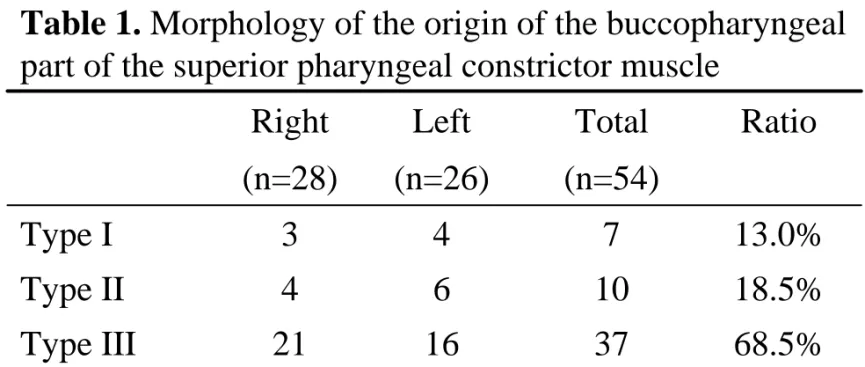
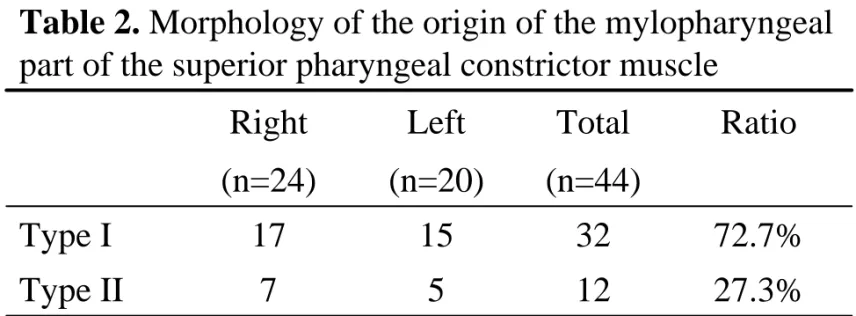

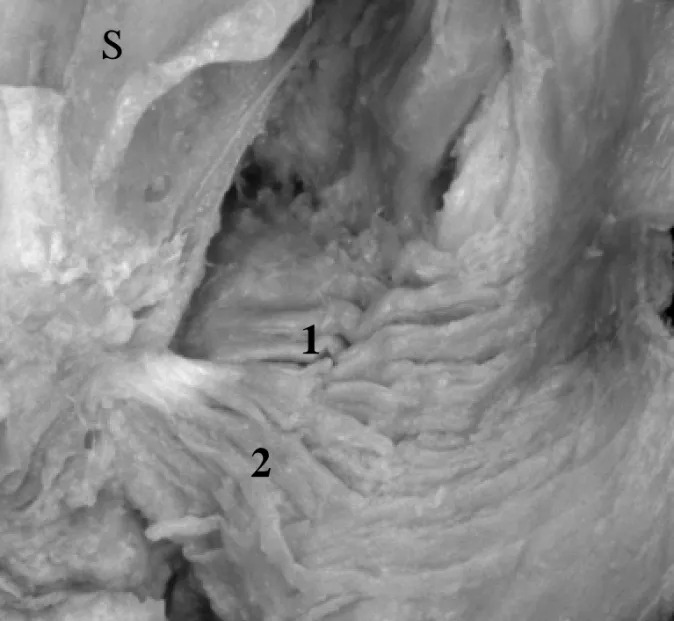
関連したドキュメント
Finally, we give an example to show how the generalized zeta function can be applied to graphs to distinguish non-isomorphic graphs with the same Ihara-Selberg zeta
As with subword order, the M¨obius function for compositions is given by a signed sum over normal embeddings, although here the sign of a normal embedding depends on the
An easy-to-use procedure is presented for improving the ε-constraint method for computing the efficient frontier of the portfolio selection problem endowed with additional cardinality
The inclusion of the cell shedding mechanism leads to modification of the boundary conditions employed in the model of Ward and King (199910) and it will be
It is suggested by our method that most of the quadratic algebras for all St¨ ackel equivalence classes of 3D second order quantum superintegrable systems on conformally flat
Keywords: continuous time random walk, Brownian motion, collision time, skew Young tableaux, tandem queue.. AMS 2000 Subject Classification: Primary:
Answering a question of de la Harpe and Bridson in the Kourovka Notebook, we build the explicit embeddings of the additive group of rational numbers Q in a finitely generated group
The main problem upon which most of the geometric topology is based is that of classifying and comparing the various supplementary structures that can be imposed on a
